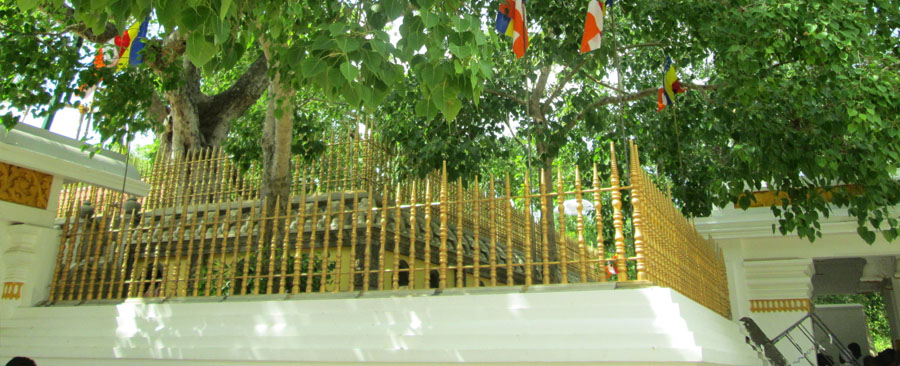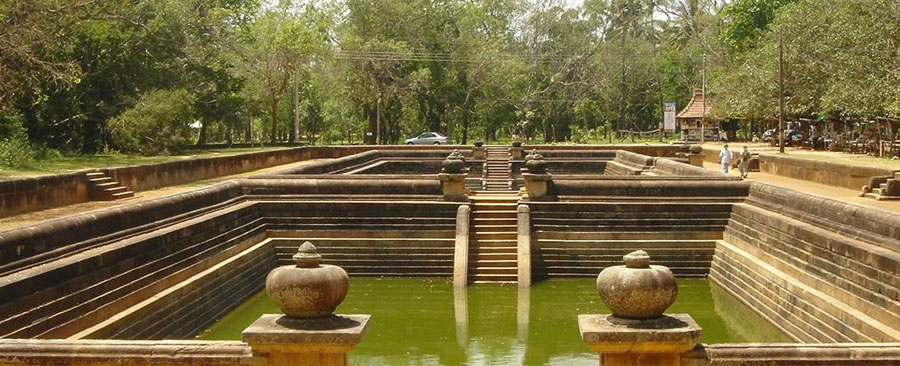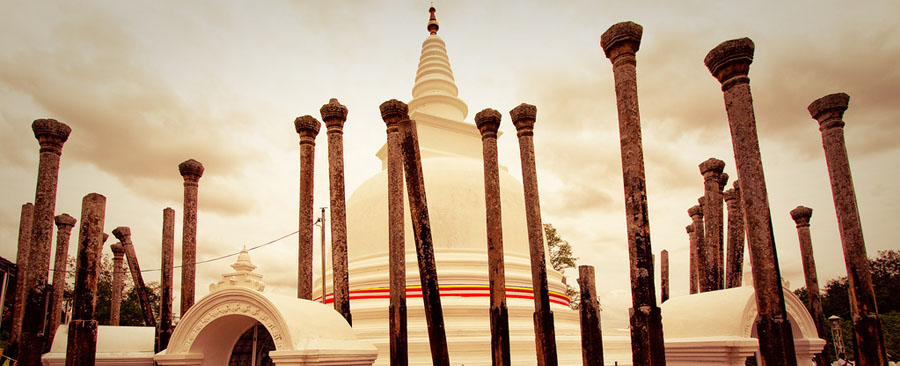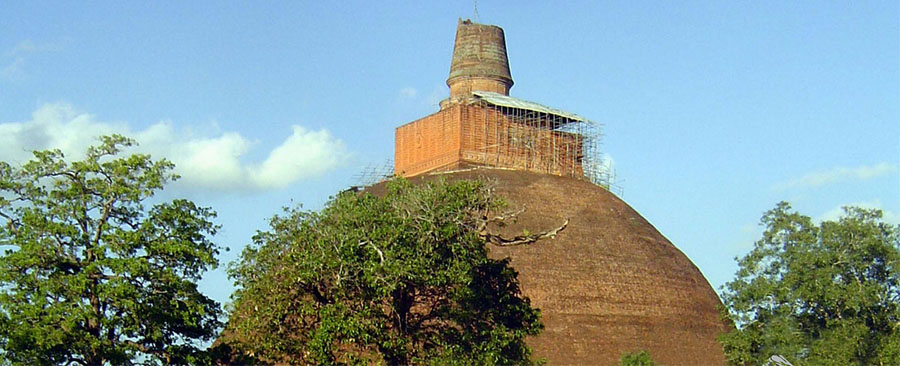
named for its capital city, was the first established kingdom in ancient Sri Lanka. Founded by King Pandukabhaya in 377 BC, the kingdom's authority extended throughout the country, although several independent areas emerged from time to time, which grew more numerous towards the end of the kingdom. Nonetheless, the king of Anuradhapura was seen as the supreme ruler of the country throughout the Anuradhapura period. Buddhism played a strong role in the Anuradhapura period, influencing its culture, laws, and methods of governance.Society and culture were revolutionized when the faith was introduced during the reign of King Devanampiya Tissa; this cultural change was further strengthened by the arrival of the Tooth Relic of the Buddha in Sri Lanka and the patronage extended by her rulers.
Invasions from South India were a constant threat throughout the Anuradhapura period. Rulers such as Dutthagamani, Valagamba, and Dhatusena are noted for defeating the South Indians and regaining control of the kingdom. Other rulers who are notable for military achievements include Gajabahu I, who launched an invasion against the invaders, and Sena II, who sent his armies to assist a Pandyan prince.
Because the kingdom was largely based on agriculture, the construction of irrigation works was a major achievement of the Anuradhapura Kingdom, ensuring water supply in the dry zone and helping the country grow mostly self-sufficient. Several kings, most notably Vasabha and Mahasena, built large reservoirs and canals, which created a vast and complex irrigation network in the Rajarata area throughout the Anuradhapura period. These constructions are an indication of the advanced technical and engineering skills used to create them. The famous paintings and structures at Sigiriya; the Ruwanwelisaya, Jetavana stupas, and other large stupas; large buildings like the Lovamahapaya; and religious works (like the numerous Buddha statues) are landmarks demonstrating the Anuradhapura period's advancement in sculpting.

In 543 BC, prince Vijaya (543–505 BC) arrived in Sri Lanka, having been banished from his homeland in India. He eventually brought the island under his control and established himself as king. After this, his retinue established villages and colonies throughout the country. One of these was established by Anuradha, a minister of King Vijaya, on the banks of a stream called Kolon and was named Anuradhagama.
In 377 BC, King Pandukabhaya (437–367 BC) made it his capital and developed it into a prosperous city. Anuradhapura (Anurapura) was named after the minister who first established the village and after a grandfather of Pandukabhaya who lived there. The name was also derived from the city's establishment on the auspicious asterism called Anura. Anuradhapura was the capital of all the monarchs who ruled the country during in the Anuradhapura Kingdom, with the exception of Kashyapa I (473–491), who chose Sigiriya to be his capital.
One of the most notable events during the Anuradhapura Kingdom was the introduction of Buddhism to the country. A strong alliance existed between Devanampiya Tissa (250–210 BC) and Ashoka of India, who sent Arahat Mahinda, four monks, and a novice being sent to Sri Lanka. They encountered Devanampiya Tissa at Mihintale. After this meeting, Devanampiya Tissa embraced Buddhism the order of monks was established in the country. Devanampiya Tissa, guided by Arahat Mahinda, took steps to firmly establish Buddhism in the country.
Soon afterwards, the bhikkhuni Sanghamitta arrived from India in order to establish the Bhikkhuni sasana (order of nuns) in the country. She brought along with her a sapling from the Sri Maha Bodhi, the tree under which the Buddha attained enlightenment, which was then planted in Anuradhapura. Devanampiya Tissa bestowed on his kingdom the newly planted Jaya Sri Maha Bodhi. Thus this is the establishment of Buddhism in Sri Lanka.

Thuparamaya is a dagoba in Anuradhapura, Sri Lanka. It is a Buddhist sacred place of veneration.
Mahinda Thera, an envoy sent by King Ashoka himself introduced Theravada Buddhism and also chetiya worship to Sri Lanka. At his request King Devanampiyatissa built Thuparamaya in which was enshrined the collarbone of the Buddha. It is considered to be the first dagaba built in Sri Lanka following the introduction of Buddhism. This is considered the earliest monument, the construction of which was chronicled Sri Lanka. The name Thuparamaya comes from "stupa" and "aramaya" which is a residential complex for monks.
Thuparamaya dagoba has been built in the shape of a bell. This dagoba was destroyed from time to time. During the reign of King Agbo II it was completely destroyed and the King restored it. What is seen presently is the construction of the dagoba, done in 1862 AD. As of today, after several renovations, in the course of the centuries, the monument has a diameter of 59 ft (18 m), at the base. The dome is 11 feet 4 inches (3.45 m) in height from the ground, 164½ ft (50.1 m) in diameter. The compound is paved with granite and there are 2 rows of stone pillars round the dagaba. During the early period vatadage was built round Thuparamaya.

The Ruwanwelisaya is a stupa in Sri Lanka, considered a marvel for its architectural qualities and sacred to many Buddhists all over the world. It was built by King Dutugemunu c. 140 B.C., who became lord of all Sri Lanka after a war in which the Chola King Elara, was defeated. It is also known as Mahathupa, Swarnamali Chaitya, Suvarnamali Mahaceti (in Pali) and Rathnamali Dagaba.
This is one of the Solosmasthana (the 16 places of veneration) and the Atamasthana (the 8 places of veneration in the ancient sacred city of Anuradhapura). The stupa is one of the world's tallest monuments, standing at 338 feet (103 m) and with a circumference of 950 ft (290 m). The Kaunghmudaw Pagoda in Sagaing, Myanmar is modeled after this stupa.

Abhayagiri Vihāra was a major monastery site of Theravada and Mahayana Buddhism that was situated in Anuradhapura, Sri Lanka. It is one of the most extensive ruins in the world and one of the most sacred Buddhist pilgrimage cities in the nation. Historically it was a great monastic centre as well as a royal capital, with magnificent monasteries rising to many stories, roofed with gilt bronze or tiles of burnt clay glazed in brilliant colors. To the north of the city, encircled by great walls and containing elaborate bathing ponds, carved balustrades and moonstones, stood "Abhayagiri", one of seventeen such religious units in Anuradhapura and the largest of its five major viharas. One of the focal points of the complex is an ancient stupa, the Abhayagiri Dagaba. Surrounding the humped dagaba, Abhayagiri Vihara was a seat of the Northern Monastery, or Uttara Vihara.
The term "Abhayagiri Vihara" means not only a complex of monastic buildings, but also a fraternity of Buddhist monks, or Sangha, which maintains its own historical records, traditions and way of life. Founded in the 2nd century BC, it had grown into an international institution by the 1st century AD, attracting scholars from all over the world and encompassing all shades of Buddhist philosophy. Its influence can be traced to other parts of the world, through branches established elsewhere. Thus, the Abhayagiri Vihara developed as a great institution vis‑a‑vis the Mahavihara and the Jetavana Buddhist monastic sects in the ancient Sri Lankan capital of Anuradhapura.


